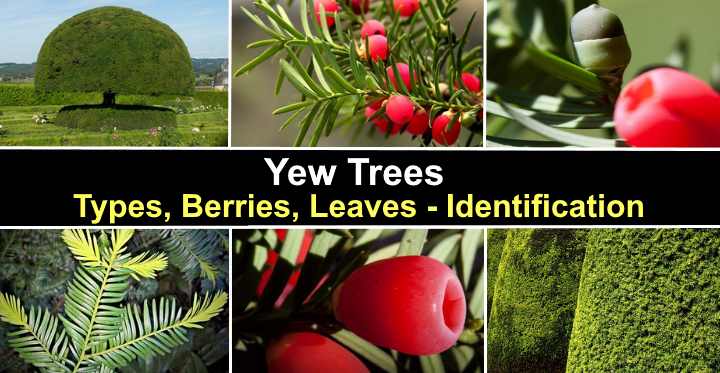The dark green linear needle-like leaves, small red berry-like fruits, and tiny insignificant flowers of yew trees make them a group of coniferous trees. Yew trees are usually medium-sized evergreen trees. The scaly brown bark, solitary-seed cones, red fruits, and linear flat leaves of yews distinguish them from other trees.
The most prevalent species is the English yew (Taxus baccata). However, decorative conifer trees include Irish yew, Western yew, and Japanese yew.
A North American species is the Western yew, sometimes known as Pacific yew (Taxus brevifolia). From Alaska to California, the American yew grows in coniferous forests. Yew shrubs are common landscaping plants for gardens, in addition to tall yew trees.
The most frequent kinds of yew trees are described in this article. Yew tree identification can be aided by descriptions and images of yew tree leaves, berries, flowers, and bark.
Yew Tree Facts
Slow-growing coniferous evergreen trees and shrubs belong to the genus Yew (botanical name Taxus). Yews, on the other hand, are long-lived trees that may survive for hundreds or even thousands of years. Between 35 and 65 feet (10 and 20 meters) tall, ornamental yew trees may be found. USDA zones 3 to 7 are ideal for yews, which are cold-hardy evergreen trees.
Yews may survive as low as -13°F (-25°C), despite the fact that shade-loving trees don’t do well in longterm hot temperatures. Dense evergreen foliage covers the branches of yew trees. Yews have low-lying branches that may touch the ground when compared to pine trees.
The crown of yews is pyramidal, with branches that tend to point upwards at the conclusion. Since the evergreen trees thrive in partial sun or deep shade, if you want to seed a yew tree as a tall hedging plant, choose a shaded location. Make sure the land is well-draining, and keep yew trees shielded from heat, drought, and full sun for more than six hours each day.

Yews shrubs and trees are poisonous, and the leaves, bark, and seeds are all dangerous. They prefer to be trimmed because of their thick evergreen foliage. The sweet red berry-like fruit known as an aril is the only part of a yew plant that is edible. The seed can be spit out after eating the cup-shaped fruit raw. According to scientists, a 50-gram packet of yew needles can kill an adult.
Yew Tree Leaves

Yew trees are distinguished by their long, narrow, flat, lanceolate needle-like leaves with rounded ends. Leaves are 0.4″ to 1.5″ (1 to 4 cm) long and 0.1″ (3 mm) broad, ranging in size from small to large. The arrangement of yew leaves along stems and spirally on upright stems is a distinctive characteristic.
The flat linear leaves of most yew species are dark green in color. The leaves on certain yew trees, on the other hand, have a blue-green underside that gives them a metallic sheen in the wind. The elevated central vein on the leaf underside can also be used to identify yew leaves.
It’s simple to distinguish yew conifers by comparing the leaves of yews to other coniferous trees. Yews have flatter leaves and don’t grow in bunches when compared to pine needles and larch tree leaves. Yew leaves, which are considerably larger than spruce leaves, grow along branches. Feathery sprays on the leaves of yew and cypress aren’t similar.
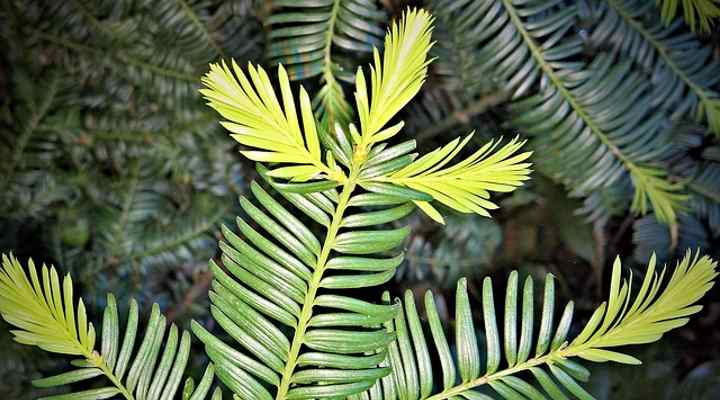
As compared to other coniferous trees, yew leaves are flatter and broader.
Yew Berries

The seed of yew trees is poisonous, however the berry-like red fruits (arils) are edible. A single poisonous seed is found in these cup-shaped fruits. The only part of the yew plant that is edible is the fleshy-red aril. Yew fruit and seeds develop directly on the stems rather than in conical cones, unlike most conifers. Yews in landscapes are easiest to identify by their crimson berry-like fall fruits and lack of cones.
Yew Flower

English yew tree pollen cones are small cream-white globe-like clusters that bloom in early spring. Male and female flowers develop on different trees in dioecious plants like yews. Little, scaly bud-like structures resembling an acorn develop from female yew blooms. They turn crimson before ripening. Male yew blooms become woody cones that resemble tiny Brussels sprouts after they’re pollinated.

Yew Tree Bark

The reddish-brown color and unusual appearance of English yew (Taxus baccata) tree bark distinguish it. The smooth bark of immature yews is speckled brown and gray in color. The bark of mature yew trees develops deep vertical ridges and furrows. Scaly bark with flaking off pieces to reveal crimson patches is depicted in photographs of yew bark.

Yew Identification
The red berry-like arils and long, flat, needle-like leaves of a yew tree are the easiest way to identify it. The evergreen leaves and lack of seed-producing ovoid or conical cones distinguish yew in the winter. Scaly bark and clusters of tiny bud-like spring blooms are two further identifying characteristics of yew trees.
Types of Yew Tree (With Pictures)
The images and identification guide for several of the most prevalent varieties of yew trees are shown below.
Common Yew / English Yew (Taxus baccata)

The English Yew, sometimes known as Common Yew, is a medium-sized tree with flat needle leaves and red fruits that grows near a solitary seed. The average height of a yew tree is 30 to 60 feet (9 to 18 meters) and the average width is 15 to 25 feet (4.5 to 7.6 meters). The pyramidal crown of the English yew distinguishes it from other conifers. The shape of the slow-growing conifer matures, however, becomes more irregular as it ages.
Little, meaty, cup-shaped entities with a seed in the middle are common yew fruits. In the autumn, the red or burgundy berry-like arils grow to 1″ (2.5 cm) in length and appear on the tree. The only part of the tree that isn’t poisonous is the red yew fruit’s flesh. The fruit has a sweet flavor that resembles berries.
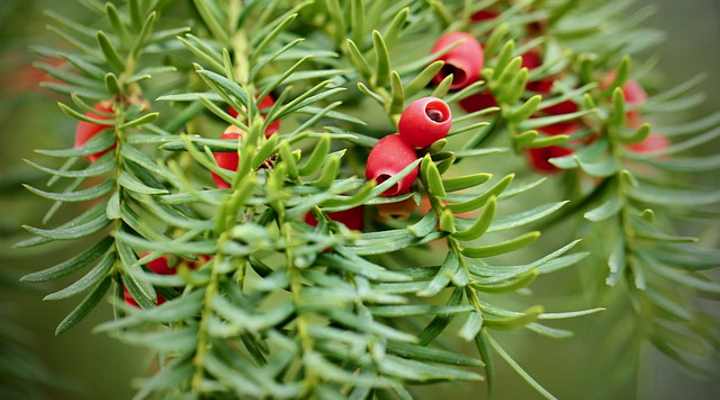
Common yew trees have a thin, scaly, crimson bark that covers a robust stem. They produce leaves and fruit. The smooth mottled bark takes on a flaky look as it matures, with fissures developing in it. USDA zones 6 through 9 are ideal for the English yew, which grows in partial to full shade.
The Taxus baccata tolerates summer heat and humidity better than other yew species. As a shade tree, evergreen hedge, and, with the correct trimming, a foundation planting, common yews are the best way to grow in a garden landscape.
Taxus baccata was the scientific name for the common yew. The fleshy red arils are referred to by the Latin name baccata. The common yew, however, is now known as Cephalotaxus harringtonia by botanists. Anglo-Japanese yew, Japanese plum yew, and spreading plum yew are some of the other popular names for the yew. Several popular yew cultivars, ranging from tiny and compact gardens to container cultivation, have various forms and sizes. English yews come in a variety of shapes and sizes:

Taxus baccata ‘David’ (left) and Taxus baccata ‘Standishii’ (right) are two small cultivars of English yew.
- Common yew ‘David’ (Taxus baccata ‘David’)—The green and gold leaves on this columnar evergreen tiny tree are arranged spirally in upright branches. It grows to be 8 to 10 feet (2.4 to 3 meters) when mature.
- Common yew ‘Dovastoniana’ (Taxus baccata ‘Dovastoniana’)—The little spreading yew tree has pendulous tips on its branches and dark green leaves. At 6 to 15 feet (1.8 to 4.5 meters) tall and 8 feet (2.4 meters) broad, the fast-growing yew matures.
- Common yew ‘Standishii’ (Taxus baccata ‘Standishii’)—The golden-yellow needle leaves and coral-red fruits of this cultivar make it a columnar evergreen tree. The yew cultivar, which grows to be 5 feet (1.5 meters) tall and 2 feet (0.6 meters) broad, is ideal for pots or tiny yards.
Yew Tree Leaves
Flat thin dark green lanceolate leaves with a length of 1.5″ (3.8 cm) and a width of 0.1″ (3 mm) are found on English (common) yew trees. The leaves of a common yew tree are flat on the bottom and twirl around a stem to create two rows. Yew leaves on upright shoots form a spiral pattern that is readily apparent.
Yew Tree Identification
The flat leaves, thin scaly brown bark, and fleshy red cup-shaped berries of the English yew tree distinguish it.
Irish Yew (Taxus baccata ‘Fastigiata’)

The Irish yew grows as a columnar thin coniferous tree with upright branches, needleshaped leaves, and beautiful crimson spherical fruits. The Irish yew tree, which grows at a pace of 12 inches (30 cm) per year and matures at 4.5 to 10 feet (1.5 to 3 meters) tall and wide, is a fast-growing conifer.
he columnar shape of an Irish yew tree, as well as stiff, upright branches with black needle clusters radiating from the stem, are the best ways to identify it. The growth of an upright yew tree declines when it reaches maturity, resulting in a flat top.
Except for the fleshy fruits, all parts of the plant are poisonous, as are yew trees. The oval coral-red berries open up in the autumn and release the seed. On upright stems, the soft linear needle leaves develop thickly. The yew’s bark is barely discernible due to its low branching growth habit, which is gray-brown in color.
USDA zones 6 to 8 are ideal for Irish yew trees. The Irish yew ‘Fastigiata,’ unlike other varieties of yew, thrives in full sun. It also grows well in most garden settings and is one of the most popular conifer in the world because it tolerates shade and is simple to cultivate.
As a hedge plant, living screen, evergreen privacy barrier, or foundation planting, Taxus baccata ‘Fastigiata’ is ideal. It can also be used in gardens to create vertical emphasis or in a shady corner of the home as an evergreen columnar tree. The magnificent yellow to lime-green leaves of the Irish yew Taxus baccata ‘Fastigiata Aurea’ The growth habits of this columnar yew are similar to those of the Fastigiata: upright branches with soft, thick leaves and coral-red fleshy berries.
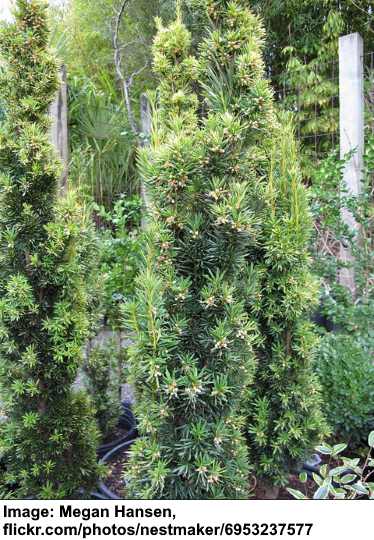
Yew Tree Leaves
Compared to English yew leaves, Irish yew tree leaves are longer. The dense foliage is created by arranging the dark green leaves spirally on stems.
Yew Tree Identification
The columnar, cigar-like form of an Irish yew tree is the quickest way to identify it. The tree produces bright red berry-like fruits, similar to those of all yew conifers.
Pacific Yew / Western Yew (Taxus brevifolia)

The Pacific yew is a medium-sized conifer with short needle-like leaves, soft brilliant scarlet round fruits, and reddish-brown bark. This needle-leaved evergreen has a dome-shaped crown and is sometimes known as the Western yew. The Pacific yew grows to be 33 to 50 feet (10 – 15 meters) tall when it reaches adulthood.
Yew trees thrive in USDA zones 4 to 6 and are very cold-hardy. Plants that are decorative thrive in both full sun and full shade, and they perform equally well. Linear needles arranged radially on stems, as well as scarlet oval fleshy fruits, are two distinguishing characteristics of Pacific yew trees.
The Western yew’s scientific name, Taxus brevifolia, refers to its short leaves. The needles are somewhat shorter than those of other yews. They, however, have the same needle form as yews: thin linear flattened needles with a rounded tip and point.
Yew Tree Leaves
Like all yews, the leaves of the Pacific yew tree are flat and lanceolate, with dark green spirally arranged needles on a stem. The twisted leaf base seems to indicate that the needle blades grow in two rows, although this isn’t clear. The little leaves, at 0.4″ to 1.1″ (1 cm) long, are among the tiniest of yew tree species’ leaves.
Yew Tree Identification
Soft green leaves in two flat rows, brilliant red fall “berries,” and thin, scaly brown bark are all indicators of Pacific yew trees.
Japanese Yew (Taxus cuspidata)
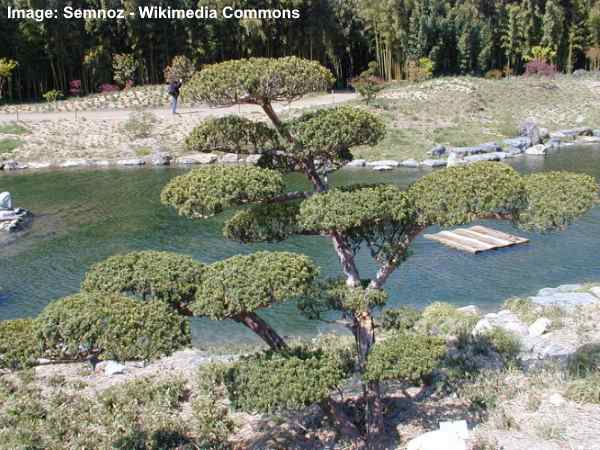
The Japanese yew tree, a spreading ornamental shrub-like tree with flat needle leaves, succulent red seeded fruits, and flaky brown bark, is frequently pruned to remove branches. Because of its wide spread, the Japanese yew is also known as the spreading yew. The yew tree can grow up to 60 feet (18 meters) tall.

The Japanese yew, sometimes known as Taxus cuspidata, has leaves and fruit similar to the common yew. This yew species is tougher and taller than the common English yew, which makes it grow faster. In addition, the leaves have two visible yellow bands on the bottom surface of the flat needle-shaped lanceolate.
Japanese yew is often grown as a dwarf cultivar or little spreading plants in North America. For aesthetic gardens, you can grow a spreading, low-growing Japanese yew tree that grows 2 to 3 feet (0.6 to 1 meter) tall and wide. As landscaping plants, some Japanese yew cultivars are available:
- Taxus cuspidata ‘Aurescens’ (Golden Japanese Yew)—It’s a tiny golden-foliaged shrub that grows to be 1 foot (0.3 meters) tall and 3 feet (1 meter) broad.
- Taxus cuspidata ‘Capitata’—A 25-foot-tall (7.6 m) pyramidal evergreen yew.
- Taxus cuspidata ‘Densa’—This 4-foot-tall (1.2-meter) dwarf shrub has an 8-foot-(2.4-meter) expanse.
Yew Tree Leaves
Flat, narrow lance-shaped blades 0.4″ to 1.18″ (1 – 3 cm) long and up to 0.1″ (3 mm) broad make up Japanese yew tree leaves. Along the stems, the little needles develop in two flattened rows. The needle leaves on upright stems, however, spiral out.
Yew Tree Identification
The columnar form, rounded growth, and spiny-tipped lanceolate needles of the Japanese yew tree may be used to identify it. This bright red autumn fruit will help you identify this evergreen tree in the fall.
Himalayan Yew (Taxus wallichiana)
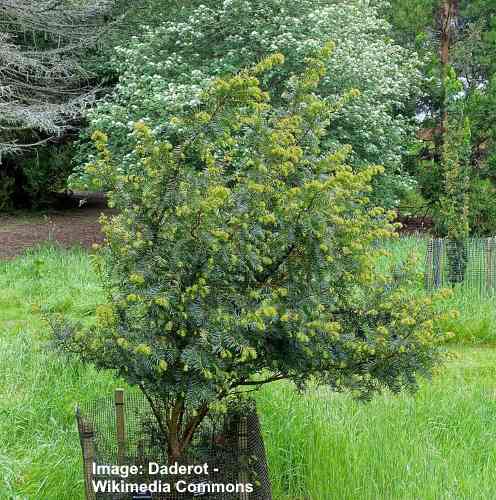
The Himalayan yew is a medium-sized conical tree with a spreading crown, thick foliage made up of dark green lanceolate-shaped leaves, and red or orange oval berries. Himalayan yews normally reach a height of 10 m (33 ft.) but may stretch to 100 ft. (30 m).
Its reddish-brown bark peels away in strips, exposing purple patches underneath. The seeds, leaves, and bark of the coniferous Himalayan yew tree are all very poisonous. The sweet fleshy red aril, which is 0.4 inch (1 cm) in diameter, is the only edible part of the yew tree.
Yew Tree Leaves

Himalayan yew tree leaves are 0.6″ to 1.4″ (1.5 cm) long and 1.5″ (4 mm) broad, and they grow in clusters of three to four leaves. The dark green leaves on yew trees are arranged radially, just like those on other yew trees. However, due to their twisted base, they seem to sprout in flattened rows down the stems on either side.
Yew Tree Identification
The pyramidal or rounded crown of a Himalayan yew tree, with upright and spreading branches densely covered in black needle-like leaves, may be used to identify it. Bright red berry-like fruits provide color throughout the fall, and evergreen foliage remains dark green all year.
